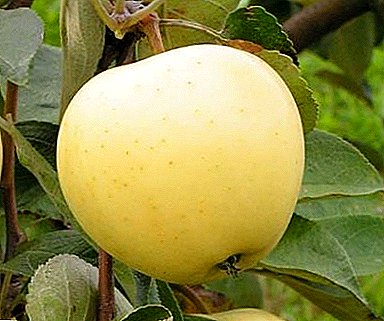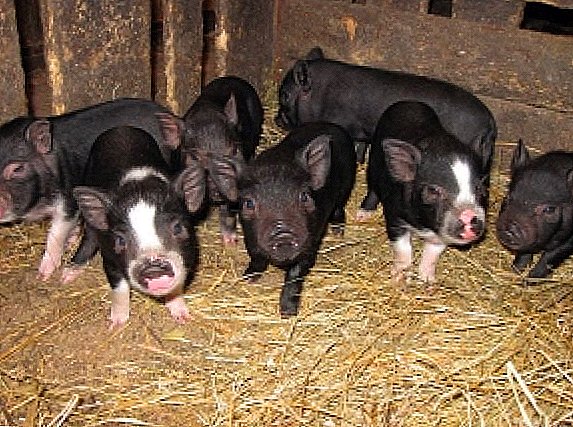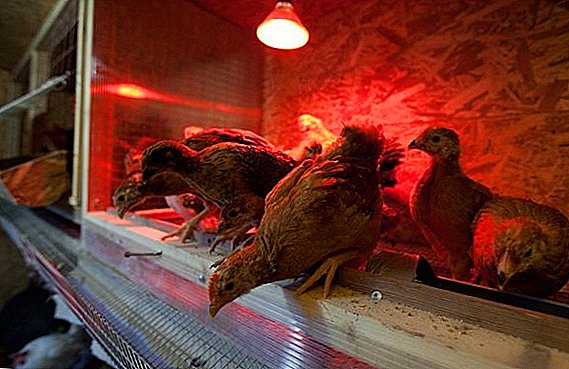 Infrared heaters are not so long ago entered into our everyday life, but already managed to gain popularity. This is a relatively inexpensive and effective way of additional or main heating, which allows to reduce energy consumption. Today it is used in apartments, offices, street spaces, and in buildings that contain pets. In small premises in the poultry and livestock also use an alternative - infrared lamps. We will talk about the advantages and disadvantages of heating the chickens with an infrared lamp in this article.
Infrared heaters are not so long ago entered into our everyday life, but already managed to gain popularity. This is a relatively inexpensive and effective way of additional or main heating, which allows to reduce energy consumption. Today it is used in apartments, offices, street spaces, and in buildings that contain pets. In small premises in the poultry and livestock also use an alternative - infrared lamps. We will talk about the advantages and disadvantages of heating the chickens with an infrared lamp in this article.
What is an infrared lamp
An infrared lamp is an ordinary light bulb that is screwed into a standard E27 ceramic cartridge. Inside the glass bulb, which can be transparent or dyed red or blue, there is a tungsten filament placed in a flask with an argon-nitrogen mixture.
The radiation of such lamps affects not all the premises, but objects and living organisms located in its immediate vicinity. Infrared rays, in contact with them, are absorbed and converted into thermal energy. It does not take time to heat - the object or the living organism feels heat immediately after the lamp is turned on.  The principle of operation of the IR light bulb is similar to the action of the Sun, the rays of which, reaching objects, heat them, and then they begin to give off heat to the environment and warm the air.
The principle of operation of the IR light bulb is similar to the action of the Sun, the rays of which, reaching objects, heat them, and then they begin to give off heat to the environment and warm the air.
Agree that the benefits of comfortable chickens are enormous. Poultry farmers are advised to learn how to choose, build and equip a chicken coop correctly, namely: to make a perch, a nest, ventilation, as well as familiarize yourself with the rules for choosing and using a fermentation bedding for chickens.
Technical characteristics of infrared lamps:
- maximum power - 50-500 W;
- maximum temperature - 600 ° C;
- IR wavelength range - 3.5-5 microns;
- supported voltage - 220 V;
- service life - 6 thousand hours.
 IR radiation does not harm either humans or animals. On the contrary, this heat source has a number of advantages:
IR radiation does not harm either humans or animals. On the contrary, this heat source has a number of advantages:- compactness;
- simplicity in work;
- the possibility of spot heating;
- uniform distribution of heat;
- rapid heating of objects and living organisms - heat comes after only 27 seconds;
- noiselessness;
- high efficiency, approaching 100%;
- environmental friendliness;
- positive effect on the behavior of animals - calming the nervous system, strengthening the immune system, increasing the rate of growth, increased appetite;
- improving hygiene and cleanliness in the room where animals are kept;
- possibility of installation in the bottom, walls, to the ceiling of the house;
- affordability.
 The disadvantages of using lamps are much less:
The disadvantages of using lamps are much less:- increased electricity costs - using a 250-watt light bulb consumes about 0.25 kW per hour;
- some discomfort during a rather long stay in the place of the light bulb action - the mucous eye of a person dries out;
- with careless handling, there is the possibility of getting burned when touched.
Did you know? Infrared rays were discovered by a scientist from England, Frederick William Herschel in 1800. He was investigating the Sun and was looking for a way to protect the instrument from overheating. Thus, the scientist accidentally discovered that the most heated objects that are under the saturated red rays.
Types of lamps for use in the poultry industry
In addition to infrared, you can use for heating chickens and other types of lamps, for example, fluorescent, LED, combined. We offer to understand the advantages and disadvantages of each of them.
Fluorescent
A fluorescent lamp is a light source in which electricity is converted into ultraviolet rays. Low energy consumption, low light bulb heating, operation time are undoubted advantages of using this light source in the house.  However, chickens feel uncomfortable with such lighting due to the frequent unpleasant flickering and its brightness. These lamps are still better to use in poultry houses with adults.
However, chickens feel uncomfortable with such lighting due to the frequent unpleasant flickering and its brightness. These lamps are still better to use in poultry houses with adults.
Read about chick breeding rules with an incubator.
LED light
Luminaires with LEDs convert electricity into optical radiation. Such light sources have a number of advantages:
- low power consumption;
- long service life;
- ease of installation and operation;
- low heating of the device;
- high mechanical strength;
- compactness;
- environmental Safety;
- regulation of the behavior of birds when emitting light of a different spectrum.

Combined
Combined light sources emit infrared and ultraviolet rays. It is believed that such devices are most useful for the body of chickens, because, in addition to heating, they also disinfect with ultraviolet light and also have a positive effect on the development of vital organs.
We recommend to get acquainted with the tips and recommendations of growing chickens.
How to use infrared lamps
Like all newborns with still imperfect thermoregulation, chicks need warmth. The need for it will decrease as the yellow lumps grow. To monitor the temperature, in the room where the children are kept, a thermometer must hang.
For newborn chickens, a very high temperature is required - 35-37 ° C. In the future, weekly it will need to be reduced by 1-2 ° C. Thus, at 9 weeks, babies will feel comfortable at a temperature of 18 to 21 ° C. It is possible to regulate the temperature by removing / approaching the heat source to the heated objects.  To choose the lamp power, it is necessary to proceed at the rate of 1 kW per 10 sq. M. m When the temperature in the room without heating is 10 ° C per 10 square meters. m enough one 600-watt light bulb. You can also calculate the power and quantity of the required heat sources using calculators placed on the Internet.
To choose the lamp power, it is necessary to proceed at the rate of 1 kW per 10 sq. M. m When the temperature in the room without heating is 10 ° C per 10 square meters. m enough one 600-watt light bulb. You can also calculate the power and quantity of the required heat sources using calculators placed on the Internet.
In order to find out how far from the chicks to place the infrared light bulb, before the birth or acquisition of young stock, place the heat source at a distance of 30-40 cm from the place where the babies will be located. After a while, the temperature should be measured. If it exceeds 37 ° C, the source should be placed higher.
Important! The room must be heated to the required temperature before the chicks are placed there.
It should be understood that the farm should be 2 IR bulbs. If something happens to one, it can be replaced in time without damage to the health of the young. The best option would be the simultaneous use of 2 light bulbs.  After one batch of young has already become firmly on its feet and no longer needs a heat source, it is necessary to wipe the cooled down bulb with a damp cloth to remove dirt and dust.
After one batch of young has already become firmly on its feet and no longer needs a heat source, it is necessary to wipe the cooled down bulb with a damp cloth to remove dirt and dust.
When purchasing cheap models with a thin bulb in order to avoid mechanical damage to the glass and injured kids should protect the bulb with a metal grid.
Poultry farmers are advised to find out what and how to feed the chickens, how to transport day-old chickens, as well as how to determine the sex of the chicken.
During the operation of infrared light bulbs, it is necessary to ensure that they are screwed only into ceramic cartridges (plastic ones will melt very quickly), so that moisture or flammable materials, such as straw, hay, feathers, etc., will not get on them. avoid moving the light bulbs - so their lifespan is significantly reduced.
When heating the house in an infrared way, adults should be kept separate from babies. Otherwise, most of the heat will go to the mature birds, and the kids will be cold. 
Chick behavior
The behavior of chickens will tell you if they are comfortable in a room heated by infrared rays. If the temperature in the hen house suits them, they will be evenly dispersed throughout the area. While eating food or water, they will cheerfully squeak. If they either crawl away in different directions and behave sluggishly, or, on the contrary, are knocked together, restless, then the conditions do not suit them.
Crowded together
When babies behave in this way, it means they are experiencing cold. It is necessary to measure the temperature and increase it by 1 or 2 degrees by reducing the distance between the infrared heat source and the location of the chicks.
Important! Since infrared lamps become very hot, it is forbidden to touch them - this is fraught with severe burns.
Crawling around
Chickens try to spread out on the sides, so as not to touch the bodies with each other, they experience sluggish behavior and heavy breathing - these are clear signs that the kids are hot. Place the infrared heat source higher. 
Advantages of using chick heating lamp
When chicks are hatched, the IR lamp, in addition to heating and lighting, has the following effect:
- dries the litter;
- maintains an optimal level of humidity in the room by evaporation of moisture;
- has a beneficial effect on the nervous system of babies, reducing their aggressiveness and reducing the level of stress;
- soft light does not irritate Kurchat;
- promotes the rapid and proper development of babies with a strong immune system;
- improves the digestive tract, including increases appetite and the level of absorption of feed.
Read how to treat and prevent chick diseases.
Thus, the infrared lamp installed in the room with young animals, allows to solve simultaneously 2 problems: lighting and heating. In addition, IR radiation has a beneficial effect on the organisms of babies, soothes them, accelerates development and growth.  It is suitable for heating young stock of all breeds, is easy to use, but still requires some precautions. Thus, the light bulbs can not be taken by hand, to allow ingress of moisture, as well as flammable objects.
It is suitable for heating young stock of all breeds, is easy to use, but still requires some precautions. Thus, the light bulbs can not be taken by hand, to allow ingress of moisture, as well as flammable objects.
Did you know? The organs of vision of humans and higher primates are not able to see infrared rays. However, other creatures have this ability. - for example, some snake species. This allows them to see the warm-blooded victim in the infrared. Boas are able to see in two ranges - normal and infrared. The same ability is endowed with piranhas, goldfish, mosquitoes.
Today, the use of infrared light bulbs is one of the most cost-effective and efficient ways of basic heating of premises with young poultry in small private farms and farms. They are also advisable to use as an additional source of lighting and heating for industrial purposes.












